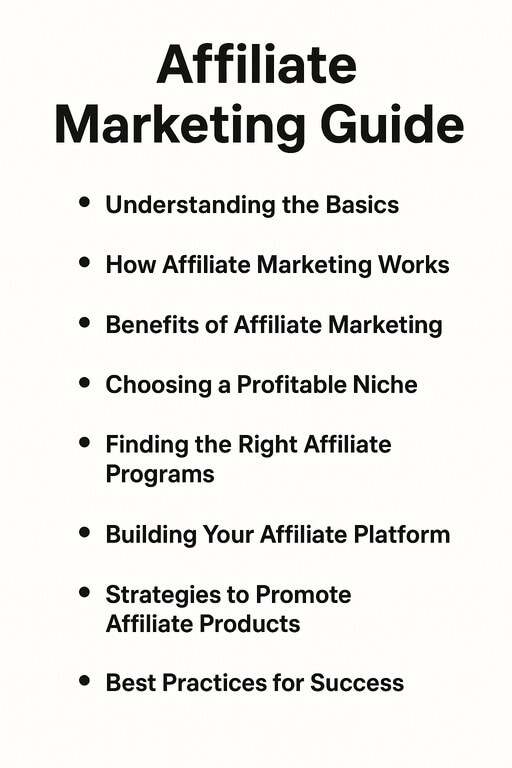Affiliate Marketing Guide is your roadmap to building a profitable online income stream without creating your own product. In this guide, you’ll learn exactly how affiliate marketing works, the steps to choose the right niche, find reliable programs, promote effectively, and avoid common mistakes — so you can start earning commissions and scaling your digital business with confidence. What contains in this Affiliate Marketing Guide.
What is Affiliate Marketing Guide?
Affiliate marketing is a performance-based online business model where a business (the merchant) pays a third-party (the affiliate or publisher) a commission for driving traffic or sales to its products or services. In simple terms, you promote a product you love, and if someone buys it through your unique link, you earn a cut of the sale. This has become one of the fastest-growing online business models because it’s a win-win for everyone involved. The merchant gets new customers, and the affiliate gets paid for their promotional efforts.
Understanding the Basics
Before diving in, let’s break down some key terms you’ll encounter:
- Affiliate: You, the individual or company that promotes the merchant’s products.
- Merchant: The company or creator of the product/service being sold.
- Commission: The percentage or flat fee you earn for each successful sale, lead, or click.
- Tracking Link: Your unique link that tracks all the clicks and conversions you generate.
- Cookie Duration: A time frame that determines how long a sale can be attributed to you after someone clicks your link. For example, a 30-day cookie means if a customer buys within 30 days of clicking your link, you still get the commission.
The affiliate marketing ecosystem operates with several key players. The merchant has a product, and the affiliate promotes it to their audience. The customer then uses the affiliate’s tracking link to make a purchase, and the affiliate earns a commission. This entire process is managed by an affiliate network or an internal affiliate program.
There are also different payment models:
- Pay-per-sale (PPS): You get paid a percentage of the sale price. This is the most common model.
- Pay-per-click (PPC): You earn a small amount each time someone clicks on your link, regardless of a sale. This is less common.
- Pay-per-lead (PPL): You get paid when a customer takes a specific action, like filling out a form, signing up for a trial, or downloading a resource.
How Affiliate Marketing Works
The process of becoming an affiliate and earning commissions is straightforward:
- Join an Affiliate Program: You sign up for an affiliate program or network, like Amazon Associates, ShareASale, or a company’s internal program.
- Get Your Unique Affiliate Links: Once approved, you’ll be given unique tracking links for the products you want to promote.
- Promote Products: You share these links through your content, whether it’s a blog post, a YouTube video, a podcast, or social media.
- Earning Commissions: When someone clicks your link and makes a qualifying purchase or completes a desired action, the sale is tracked and you earn a commission.
Here’s an example of a typical transaction:
Imagine you have a blog about hiking gear. You write a review of a specific hiking backpack and include your unique Amazon Associates affiliate link. A reader clicks the link, goes to Amazon, and buys the backpack. Amazon’s system tracks the sale, and a few weeks later, you get a commission on that purchase. This Affiliate Marketing Guide will help you to earn some extra income.
Benefits of Affiliate Marketing
Affiliate marketing offers several advantages that make it an attractive business model:
- Low Investment, High Potential: You don’t need to invest in creating a product or managing inventory. Your primary investment is time and effort in creating content and building an audience.
- Work from Anywhere: All you need is a laptop and an internet connection. This provides the flexibility to work from home or anywhere in the world.
- No Product Creation Required: You can start earning without the hassle of product development, customer service, or shipping logistics. You simply promote products that already exist.
- Passive Income Possibilities: Once your content is published, it can continue to drive traffic and sales for months or even years, earning you commissions around the clock.
Choosing a Profitable Niche
Selecting the right niche is crucial for your success. It determines your audience, the products you’ll promote, and your potential for earnings.
Why it Matters: A well-defined niche allows you to focus your efforts, build authority, and attract a highly targeted audience. Trying to appeal to everyone usually results in appealing to no one.
How to Research: Look for niches with a strong demand, high-value products, and a decent number of available affiliate programs. Tools like Google Trends can help you identify rising interest in a topic.
Balancing Passion vs. Profitability: The ideal niche is where your passion and a profitable market intersect. While it’s great to be passionate about a topic, if there are no products to promote or the commissions are too low, it may not be a viable business. On the other hand, a highly profitable niche you have no interest in can quickly lead to burnout. Strive for a balance.
So, are you ready to start exploring a niche and building your affiliate marketing business? Then read continue this Affiliate Marketing Guide.
Finding the Right Affiliate Programs
There are two main types of affiliate programs:
- Individual Company Programs: These are managed directly by companies—examples include Shopify, Bluehost, or Nike. They often offer unique rewards, personalized support, and may work well for a niche audience.
- Affiliate Networks: Platforms like Amazon Associates, ShareASale, and CJ Affiliate aggregate lots of brands, allowing you to join multiple programs via one network.
Key factors to consider when choosing programs:
- Commission Rate: As explained in this Affiliate Marketing Guide, how much you earn per sale or action matters — higher rates can yield more income but may be tied to harder-to-sell products.
- Payment Terms: The Affiliate Marketing Guide suggests considering payout thresholds, frequency, and available payment methods (PayPal, direct deposit, etc.) before committing.
- Support: Look for networks or brands that offer strong affiliate support, resources, and prompt responses; this is a key success factor highlighted in the Affiliate Marketing Guide.
- Product Quality: Focus on promoting products you trust or use; quality products mean higher conversions and less risk to your reputation.
Building Your Affiliate Platform
Platform Options:
- Blog/Website: Most popular. Allows rich content, On Page SEO, and long-term growth.
- YouTube Channel: Effective for tutorials, reviews, and unboxings.
- Social Media: Instagram, TikTok, and Facebook for visual or impulse-driven products.
- Email Marketing: Directly reach subscribers with product recommendations and exclusive offers.
- Podcasts: Integration of affiliate promotions into episodes or show notes.
Website Essentials for Affiliates:
- Domain & Hosting: Invest in a custom domain and reliable hosting for credibility and performance.
- CMS (Content Management System): WordPress is the most common, with plugins for SEO and affiliate links.
- Design: Clean, fast-loading, and mobile-friendly design enhances user experience and trust.
SEO Basics for Affiliate Sites:
- Target relevant keywords with search intent.
- Optimize on-page elements (titles, meta descriptions, headers).
- Publish high-value, original content regularly.
- Build backlinks and improve site speed.
Strategies to Promote Affiliate Products
- Content Marketing: As discussed in this Affiliate Marketing Guide, create blogs, in-depth reviews, tutorials, and product comparisons to provide value and context for affiliate offerings.
- Social Media Marketing: The Affiliate Marketing Guide recommends sharing product highlights, demos, or results on popular platforms to engage your audience.
- Email Marketing Campaigns: Build lists and send targeted product recommendations or deal alerts for better conversions, following strategies outlined in this Affiliate Marketing Guide.
- Paid Ads: Google Ads and Facebook Ads can drive fast, targeted traffic but come with costs. They’re not suitable for everyone and can erode profits if not managed well. Weigh the potential reach against budget and risk.
- Influencer Collaborations: Work with influencers to expand your reach and gain credibility with new audiences.
Best Practices for Success
- Focus on Trust and Transparency: Disclose affiliate relationships clearly and recommend products honestly.
- Write Honest Reviews: Share both pros and cons to build credibility and aid real purchasing decisions.
- Use Multiple Traffic Sources: Don’t rely solely on one channel—combine organic, social, and paid channels for better stability.
- Test and Optimize Campaigns: Experiment with different content formats, landing pages, or placements to find what works best.
- Track Clicks, Conversions, and ROI: Use analytics tools to monitor performance and refine your strategies.
Common Mistakes to Avoid
- Promoting Too Many Products: As highlighted in this Affiliate Marketing Guide, spreading yourself too thin can confuse your audience and weaken your authority.
- Ignoring Audience Needs: The Affiliate Marketing Guide emphasizes that you should always prioritize your audience’s interests; irrelevant promotions will erode trust.
- Not Disclosing Affiliate Links: It’s both a legal and ethical obligation, as mentioned in our Affiliate Marketing Guide, to notify your readers when you use affiliate links.
- Copying Other Affiliates’ Content: Always add your own insights and value—originality helps you stand out and rank better.
Tools & Resources for Affiliate Marketers
To run a successful affiliate marketing business, you need the right tools to streamline your efforts. Here are some essential tools and resources:
Keyword Research Tools
Finding the right keywords is crucial for driving organic traffic. Some top tools include:
- Ahrefs – Offers in-depth keyword analysis, competitor research, and backlink tracking.
- SEMrush – Provides keyword insights, site audits, and PPC research.
- Ubersuggest – A budget-friendly option for keyword suggestions and SEO analysis.
Link Tracking Tools
Managing affiliate links efficiently helps maintain a clean and professional website. Popular tools include:
Pretty Links – Shortens and tracks affiliate links while masking long URLs.
ThirstyAffiliates – Organizes and cloaks affiliate links for better management.
Analytics Tools
Tracking performance helps optimize your strategy. Useful tools include:
Google Analytics – Monitors website traffic, user behavior, and conversions.
Hotjar – Provides heatmaps and session recordings to understand visitor engagement.
Email Marketing Platforms
Building an email list is key for long-term success. Top platforms include:
ConvertKit – Great for creators with automation and segmentation features.
Mailchimp – User-friendly with customizable templates and analytics.
Legal & Ethical Considerations
Affiliate marketers must follow legal guidelines and maintain ethical practices to build trust and avoid penalties.
FTC Guidelines for Affiliate Disclosure
Clearly disclose affiliate relationships with phrases like “This post contains affiliate links.”
Place disclosures where they’re easily noticeable (not hidden in footers).
GDPR Compliance for Data Collection
If collecting user data (e.g., emails), ensure compliance with GDPR (for EU visitors).
Provide clear privacy policies and opt-in consent forms.
Honesty and Brand Reputation
Only promote products you genuinely believe in.
Avoid misleading claims to maintain credibility with your audience.
Scaling Your Affiliate Marketing Business
Once you start earning, focus on growth strategies to maximize revenue.
Building an Audience
Engage with followers on social media, forums, and email newsletters.
Offer value through free guides, webinars, or exclusive content.
Creating Evergreen Content
Publish content that stays relevant over time (e.g., “Best [Product] for [Need]”).
Update old posts to keep them ranking in search engines.
Outsourcing Content Creation & Marketing Tasks
Hire freelancers for writing, SEO, or graphic design to save time.
Use virtual assistants for administrative tasks.
Expanding into Multiple Niches
Once established, diversify into related niches to reach new audiences.
Cross-promote products to leverage existing traffic.
By leveraging the right tools, staying compliant, and scaling strategically, you can turn using this affiliate marketing guide into a sustainable and profitable business.

Conclusion
Affiliate marketing guide is a powerful way to earn income online with the right strategy, niche, and consistent effort. Follow this Affiliate Marketing Guide.
Start small, stay authentic, and let your results grow steadily over time. Watch our video


